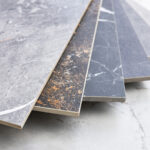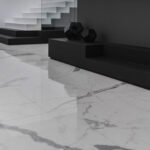Index
- Introduction
- What are ceramic grits: technical details
- The Sicer production process: from frit to calibrated grit
- Sicer product range: specialized technical characteristics
- Industrial application technologies
- Sicer technological innovations and research
- Quality control and industrial testing
- Industrial applications and technical performance
- Sustainability and environmental impact
- Conclusions and future prospects
- FAQ
Introduction
Ceramic grits are crushed, sieved, calibrated glass materials applied to the surface of tiles to achieve functional or decorative effects. They are a crucial element in the development of technical ceramic surfaces, both in terms of aesthetics and performance. Sicer plays a strategic role in this field, having developed advanced and customized solutions for the ceramic industry thanks to its consolidated know-how and strong focus on research.
What are ceramic grits: technical details
Ceramic grits are glassy materials obtained by melting ceramic frits, which are then crushed and calibrated. Their internal structure can be completely glassy or contain crystalline phases (such as plagioclase or wollastonite), which give them specific properties such as high mechanical resistance or greater surface opacity.
Composition and glass structure
The chemical composition of grit varies depending on the desired effect. It generally consists of:
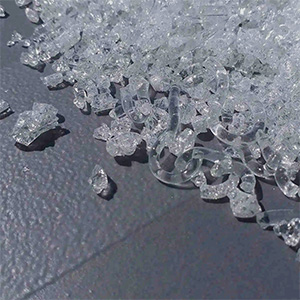
- silicon, aluminum, sodium, calcium, and boron oxides
- any colorants or metal oxides to achieve decorative effects
- functional additives to improve adhesion, fusion, and thermal compatibility
During cooling, an amorphous glass matrix is formed. In some formulations (e.g., Sicer’s GHR line), controlled nucleation of crystals within the glass phase is promoted to increase abrasion resistance.
Physical-mechanical properties
The main technical properties include:
- controlled transparency or opacity
- chemical resistance (e.g., HCl 3–18%) and mechanical resistance (abrasion, scratching, foot traffic)
- controlled thermal expansion coefficient (COE)
- adhesion to the ceramic substrate, essential for application compatibility
In combination with the substrate and installation technologies, these properties make it possible to obtain high-performance technical surfaces, such as mirror finishes, non-slip finishes, or wear-resistant coatings.
Classification and industrial applications
Grits are classified by:
- end use: for example, for natural surfaces (GHR by Sicer), mirrored surfaces (GRA-DRY LUX by Sicer), colored or reactive surfaces (GRC/GRS by Sicer)
- application method: dry, wet, digital
- technical behavior: fusibility, chemical resistance, aesthetic compatibility
They are used in the ceramic industry to obtain:
- lapped or semi-gloss tiles
- non-slip surfaces (read the article on non-slip flooring)
- high-definition decorations
- low-reflection finishes
Technical reference parameters
Each formulation is characterized by parameters such as:
- COE (Coefficient of Thermal Expansion): e.g. 51–85 x10⁻⁷ °C⁻¹
- characteristic temperatures (sintering, melting, softening)
- particle size distribution curve (e.g. 0.034–0.355 mm)
- glass refractive index (which influences transparency and brilliance)
- abrasion resistance (PEI UNI EN ISO 10545-7 test)
The Sicer production process: from frit to calibrated grit
The production process for ceramic grit at Sicer is highly automated and monitored at every stage:
- Frit melting in high-temperature kilns
- Controlled crushing using grinding technologies
- Sifting and calibration to obtain a constant grain size distribution curve
- Laboratory checks on COE, viscosity, and chemical composition
Process standardization ensures absolute batch repeatability, a fundamental requirement for industrial ceramic companies.
Sicer product range: specialized technical characteristics
The Sicer ceramic grits range of consists of several series, each designed to meet specific application requirements.
GHR grits – Technical series for natural surfaces

GHR grits are the most advanced solution for creating high-resistance natural surfaces. Their main characteristics are:
- high transparency
- resistance to abrasion and scratches
- anti-reflective effect and natural feel
They can be applied dry or wet, with excellent results even in high-traffic environments or those subject to mechanical stress.
GRA grits – Neutral series for customization
GRA grits are transparent, glossy or semi-glossy grits, characterized by:
- good fusibility and compactness of the glass
- high transparency and excellent development of digital colors
- high cleanability and flatness
The range includes different products that can be mixed together, ideal for customization and production optimization.
GRA-DRY LUX grits – For mirror-finished surfaces
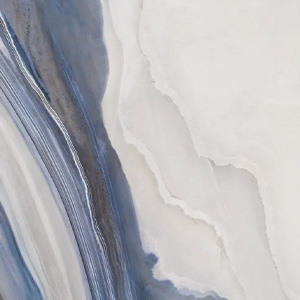
Designed for dry application, GRA-DRY LUX grits allow you to achieve:
- ultra-bright surfaces
- controlled expansion coefficient
- no porosity and glassy depth
They are suitable for light and dark substrates, with high performance even under variable production conditions.
GRAN LUX grits – For wet applications
Used in wet grinding, GRAN LUX grits allow you to achieve:
- extreme brilliance on large surfaces
- perfect complementarity with the DRY LUX series for hybrid finishes
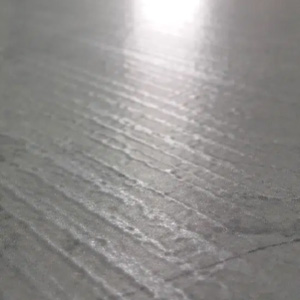
GRC and GRS grits – Colored and special solutions
The series GRC (melt-colored) and GRS (special/metallic) offer:
- color effects integrated into the mass
- reactive effects and oxide-based decorations
- customized solutions for projects with high aesthetic or technical requirements
Industrial application technologies
Ceramic grits can be applied using different technologies depending on the desired aesthetic and functional result, the characteristics of the substrate, and the plant constraints. Sicer offers optimized solutions for all major industrial application methods.
Dry application – Advanced technology
Dry application is an advanced technique that allows the use of grits through controlled deposition systems, in combination with water-based adhesives. It is particularly suitable for highly automated production and where high transparency and surface compactness are required.
The main technical advantages include:
- uniform deposition of large quantities,
- reduced microporosity and increased cleanability,
- optimal development of digital colors in the underlying graphics.
From an environmental point of view, this process allows:
- the elimination of water use in the production line,
- a drastic reduction in energy consumption,
- a lower overall impact on the production plant.
The process consists of three integrated stages: distribution, bonding using water-based adhesives, and controlled fusion. Each step is monitored by in-line quality control systems to ensure aesthetic consistency and stable technical performance.
Wet application – Advanced traditional systems
Wet application is a well-established technique that involves suspending the granules in water and then distributing them using airless or veil systems. Sicer designs optimized formulations for these systems, calibrating the particle size and density of the product according to the customer’s plant.
Main advantages:
- homogeneous deposition even on large surfaces,
- easy adaptation to complex or structured surfaces,
- control over the formation of the final glassy film.
This technique is ideal for high-speed production lines, where it is essential to maintain stability and regularity even in the presence of variations in format or relief.
Digital application with water-based adhesives
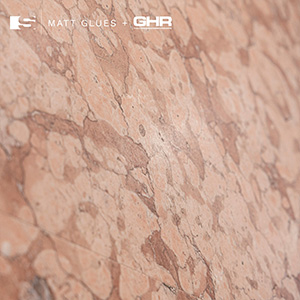
Digital application represents the future of precision technical decoration. The grits are selectively distributed using inkjet or precision coating systems, with the aid of high-efficiency water-based adhesives.
Main features:
- possibility of applying variable quantities with millimeter resolution,
- creation of complex and localized aesthetic effects,
- full compatibility with digital printing and multi-layer graphics.
This technology also guarantees low emissions (VOC), meets the latest environmental sustainability requirements, and allows precise control of adhesion and fusion even on technical substrates.
Technological innovations and research at Sicer
Research and development is at the heart of innovation at Sicer. The company constantly invests in advanced formulations and the development of high-performance ceramic materials, with an integrated approach involving its in-house laboratory, industrial collaboration, and technology transfer.
Development of new formulations
In recent years, Sicer has introduced technical grits with enhanced properties, such as high-strength GHR, the GRA-DRY LUX for mirror-finished surfaces series , and NEXT EXPERIENCE SURFACES for anti-reflective textured surfaces. These products are the result of intensive work to optimize the glass structure, control the COE, and study the melting curves based on industrial firing cycles.
Research into eco-friendly materials
Alongside technical performance, Sicer promotes research focused on environmental sustainability. The lines of development focus on:
- low-VOC formulations for digital applications
- water-based adhesive-compatible grits
- reduction of energy consumption during firing thanks to low-melting-point glass
- optimization of the mass/surface ratio to minimize consumption
These solutions meet the needs of an industry that is increasingly attentive to environmental regulations and industrial carbon footprints.
Co-development with ceramic partners
A distinctive feature of Sicer’s approach is its direct collaboration with ceramic manufacturers to design tailor-made solutions. The technical department works in close synergy with customers’ R&D departments, analyzing actual plant conditions, aesthetic constraints, and performance targets to develop customized and replicable materials.
This co-engineering approach reduces testing times, improves aesthetic performance, and guarantees production stability even on complex batches.
Quality control and industrial testing
Quality control is a fundamental stage in the production process of Sicer ceramic grits. Each batch undergoes a structured set of laboratory tests to ensure consistent technical performance and compliance with international ceramic standards.
Grain size control
The grain size curve is verified using laser instruments or optical analyzers, in accordance with the tolerances specified by the customer and the process specifications. The control applies to both the dry mass and the product after humidification, to simulate its behavior in line.
D10–D50–D90 is monitored to ensure uniform melting and predictable behavior in application.
Characteristic temperature test
Each formulation is characterized using a heating microscope, measuring the following parameters:
- Sintering point (start of vitrification)
- Softening point (start of softening)
- Sphere and 1/2 sphere (complete melting)
- Melting point (free fluid)
These values are essential for calibrating firing cycles and matching ceramic substrates.
Chemical analysis and impurity control
Composition is checked using X-ray fluorescence (XRF) and ICP-OES instruments to ensure the chemical repeatability of batches and the absence of critical contaminants (e.g., heavy metals, unwanted oxides). Chemical resistance tests are also carried out in accordance with UNI EN ISO standards (e.g., HCl acids 3–18%).
Certifications and compliance
Sicer grits are developed in compliance with the main European and international standards for the ceramic industry:
- UNI EN ISO 10545-7 (abrasion resistance – PEI test)
- EN 16165 (anti-slip properties – pendulum test)
- REACH and RoHS for chemical safety
Each batch is tracked with a technical data sheet and analysis certificate to guarantee the quality and safety of the finished product.
Industrial applications and technical performance
The ceramic grits developed by Sicer are used in a wide range of industrial contexts, combining high performance and aesthetic versatility. Each formulation is designed to meet specific requirements in terms of mechanical resistance, optical behavior, adhesion to the substrate, and durability over time, in line with the needs of advanced ceramic manufacturers.
Non-slip surfaces for industrial safety
GHR grits and formulations for NEXT EXPERIENCE SURFACES allow surfaces with an optimized friction coefficient (e.g., R10–R12) to be obtained, ideal for flooring in high-traffic contexts, humid environments, or loading/unloading areas.
The surface structure generated complies with current regulations (EN 16165) while maintaining good cleanability and visual uniformity.
Mirror finishes for architectural applications
The GRA-DRY LUX and GRAN LUX series are designed to create mirror-finished surfaces with high levels of brilliance and deep glass-like transparency. These solutions are particularly popular in premium architectural and residential applications, where a balance between aesthetic value and technical performance is sought.
Control of the expansion coefficient ensures perfect integration with the firing cycles of large slabs or technical formats.
Decorative effects and advanced textures
Fused colored grits (GRC) and metallized or reactive solutions (GRS) allow you to create high-definition decorative effects, complex surface textures, and dynamic color interactions with the underlying digital graphics.
These formulations are suitable for both exposed surfaces in indoor environments and for outdoor cladding subject to thermal stress, maintaining visual and chromatic stability over time.
Wear resistance and durability
All technical series are tested for abrasion resistance (PEI), thermal shock, chemical attack, and mechanical stress. GHR grits, in particular, are characterized by a highly compact glass-crystalline phase, which ensures:
- long-lasting durability in commercial or industrial environments
- maintenance of aesthetic appearance over time
- low wear from foot traffic or mechanical handling
- durabilità prolungata in ambienti commerciali o industriali
- mantenimento dell’aspetto estetico nel tempo
- bassa usura da calpestio o movimentazione meccanica
Sustainability and environmental impact
In the current context, the ceramic industry is called upon to combine innovation and environmental responsibility. Sicer responds to this challenge by integrating sustainable solutions into every stage of its grit production cycle, from the development of raw materials to the industrial application phase.
Low environmental impact technologies
Sicer formulations are designed to be compatible with dry or digital application technologies, which drastically reduce the use of water in the production line and minimize emissions into the atmosphere. The grits are developed with low-melting-point glass, which reduces energy consumption during firing.
These solutions meet the requirements of best available techniques (BAT) for sustainable ceramic production.
Reduction in energy and water consumption
Sicer’s technical grits are optimized for efficient thermal cycles and allow for:
- shorter firing times
- lower peak temperatures
- elimination of water in the application phase (for dry processes)
This translates into a direct reduction in energy and water consumption, with both environmental and economic benefits for the ceramic manufacturer.
Waste management and circular economy
Sicer’s internal grit production processes adopt a circular economy model, which includes:
- recovery of washing water and recycling in a closed cycle
- reuse of glass waste in new frits
- dust abatement and collection of fine residues for new formulations
This approach minimizes non-reusable waste, contributing to the efficiency of the system as a whole.
Water-based adhesives and eco-friendly solutions
The use of water-based adhesives, compatible with the entire range of dry grits, is one of the most significant innovations in terms of environmental friendliness. These adhesives:
- are free from volatile organic compounds (VOCs)
- ensure effective adhesion without the need for pre-treatment
- comply with REACH regulations and do not require intensive ventilation in line
In combination with eco-optimized grits, these technologies enable the creation of ceramic products with a reduced environmental impact, in line with market demands and building environmental certifications (e.g., LEED, BREEAM).
Conclusions and future prospects
Ceramic grits are a key technical element in the development of advanced surfaces. Thanks to Sicer’s technological contribution, the ceramic sector can now count on more high-performance, sustainable, and customizable materials. The next challenges will involve integration with artificial intelligence in quality control systems and advanced automation in application processes.
FAQ – Frequently asked questions about Sicer ceramic grits
FAQ
Ceramic grits are crushed and calibrated glass materials used to obtain technical surfaces with high aesthetic and functional properties. They are used to create effects such as transparency, slip resistance, mirror polishing, reactive decorations, or mass coloring.
Sicer grits offer:
– guaranteed industrial repeatability from batch to batch
– compatibility with all application technologies (dry, wet, digital)
– products optimized for high technical performance and environmental sustainability
– technical support for customized applications
For extra-bright surfaces, we recommend the GRA-DRY LUX series, designed for dry application and deep lapping, or GRAN LUX for wet lapping. Both guarantee glass-like transparency, controlled expansion coefficient, and absence of porosity.
The choice depends on:
– application technology (dry, wet, digital)
– substrate and firing cycle used
– desired effect (glossy, natural, non-slip, colored)
– technical constraints (temperature, COE, abrasion)
The Sicer technical team assists the customer in defining the grain size curve, COE, and aesthetic-functional compatibility.
Yes, all dry application lines (e.g., GHR, GRA-DRY LUX) are perfectly compatible with water-based adhesives, which guarantee excellent adhesion, low environmental impact, and ease of use in industrial lines.
Yes. All batches are accompanied by:
– complete technical data sheet
– granulometric and compositional analyses
– testing in accordance with UNI EN ISO standards (e.g., 10545-7 for abrasion, EN 16165 for slip resistance)
– REACH, RoHS, and VOC compliance certifications



